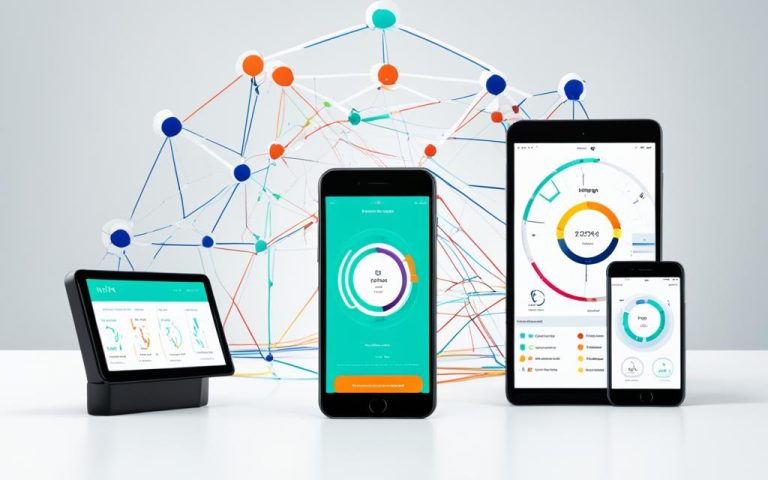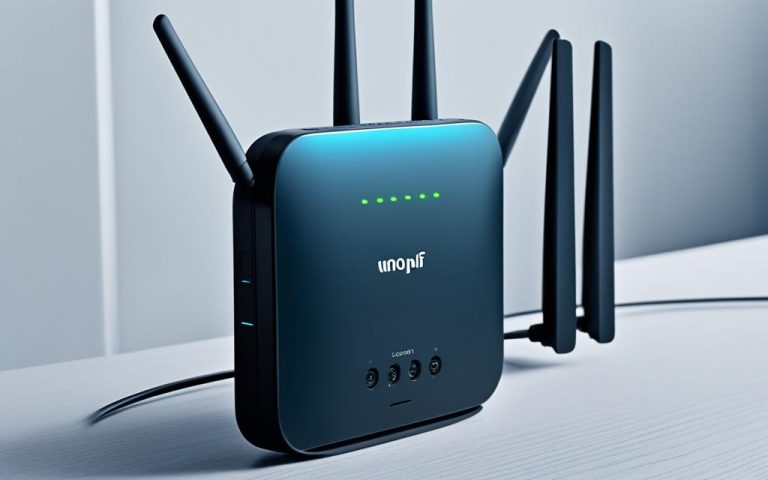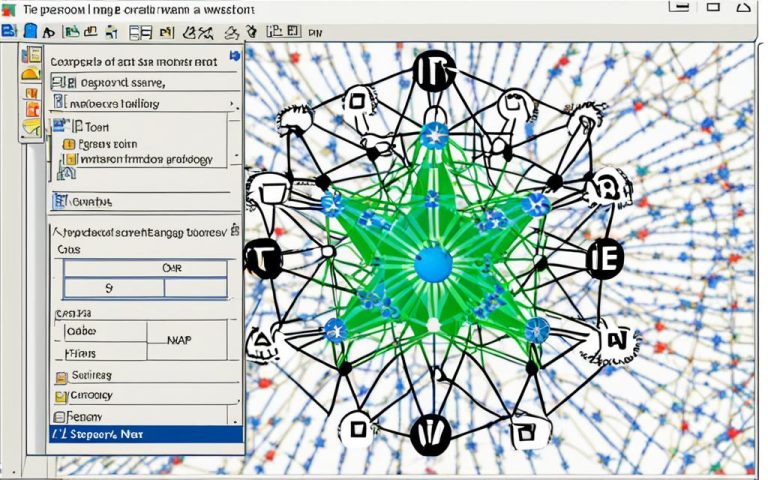Data synchronization is crucial in personal area networks (PANs) to ensure consistent and up-to-date data across different devices or systems. When the internet connection is cut off, implementing efficient data synchronization techniques becomes essential. This article will explore the various techniques for efficient data synchronization in PANs, focusing on the challenges faced and the advantages it offers.
In this section, we will delve into the understanding of data synchronization in personal area networks. We will explore how this process establishes consistency and consolidation of data between different devices. With the increasing usage of PANs, it is essential to grasp the fundamentals of data synchronization to avoid isolated data silos, conflicting data states, duplicate data, and outdated information.
Implementing data synchronization in PANs comes with its fair share of challenges. Asynchrony, conflicts, slow bandwidth, flaky networks, third-party applications, and different file systems are some of the hurdles to overcome. Managing these challenges requires careful consideration of resource sensitivity, efficient utilization of network bandwidth, and ensuring data privacy and security.
There are several techniques that can be employed for efficient data synchronization in PANs. Local data storage, offline data tracking, internet connection restoration detection, synchronization process, conflict resolution, and updating local storage are few examples. These techniques play a vital role in storing data locally, tracking changes when offline, synchronizing the data when the internet connection is restored, and effectively resolving conflicts.
Let’s consider a specific scenario of an inventory management app used by retail store employees. In this scenario, the app needs to handle data synchronization when the internet connection is disrupted. The app should allow employees to update inventory data even when offline and synchronize the changes with the backend server once the connection is restored. By implementing the techniques mentioned earlier, seamless data synchronization can be achieved.
Implementing data synchronization in PANs offers several advantages. It ensures data consistency, avoids isolated data silos, conflicting data states, and duplicate data. Efficient communication and collaboration between devices, accurate data-driven insights, and effective management of data privacy and security are some of the benefits organizations can experience. Furthermore, selective data synchronization in edge computing can reduce data volumes, lower mobile networking and cloud costs, and improve data ownership and security.
In conclusion, efficient data synchronization techniques are crucial in personal area networks to maintain consistent and up-to-date data. By understanding and implementing these techniques, organizations can ensure seamless data synchronization in their PANs, leading to improved efficiency and enhanced data management.
Understanding Data Synchronization in Personal Area Networks
Data synchronization is an essential process in personal area networks (PANs) that ensures the establishment of consistency and consolidation of data between different devices. The purpose of data synchronization is to mirror data sets from multiple data stores as closely as possible. However, this process is complex and involves handling various challenges such as asynchrony, conflicts, slow bandwidth, flaky networks, and different file systems.
Implementing data synchronization in PANs is crucial for maintaining data consistency and avoiding isolated data silos, conflicting data states, duplicate data, and outdated information. By understanding the intricacies of data synchronization, organizations can effectively manage their PANs and ensure seamless communication and collaboration between devices.
“Understanding data synchronization is crucial for maintaining consistent and up-to-date data in personal area networks.”
To give you a better grasp of data synchronization in PANs, let’s take a look at an example:
Example: Synchronizing Data in a Smart Home
In a smart home setup, data synchronization plays a vital role. Imagine a scenario where various smart devices like thermostats, security cameras, and lighting systems are connected to a central hub. To ensure efficient data synchronization, the smart home system must consistently update and mirror the status, settings, and preferences across all devices.
| Device | Data Sync Status |
|---|---|
| Thermostat | Synced |
| Security Camera | Synced |
| Lighting System | Synced |
In this example, data synchronization ensures that all devices in the smart home are consistently updated. If a user adjusts the temperature on the thermostat, the change is synchronized and reflected in real-time across all connected devices. This synchronization process enables seamless control and monitoring of the smart home environment.
By understanding the intricacies of data synchronization in PANs and adopting efficient techniques, organizations can effectively manage data consistency and avoid potential issues caused by conflicting or outdated information.
Challenges in Data Synchronization for PANs
Implementing data synchronization in personal area networks (PANs) presents its fair share of challenges. These challenges encompass various aspects, including asynchrony, conflicts, slow bandwidth, flaky networks, third-party applications, and file systems with different semantics.
One of the primary challenges of data synchronization in PANs is dealing with asynchrony. Asynchrony occurs when data updates are not transmitted simultaneously between devices, leading to inconsistencies and conflicts. This issue becomes more pronounced in scenarios where multiple devices are simultaneously making changes to shared data.
Conflicts are another obstacle to seamless data synchronization. Conflicts can occur when two or more devices attempt to update the same piece of data simultaneously or when conflicts arise due to differences in the interpretation or semantics of data. Resolving conflicts and ensuring the accuracy and consistency of data becomes crucial in PANs.
Furthermore, limited bandwidth and unreliable network connections pose significant challenges in data synchronization. Slow bandwidth can result in delays in transmitting data updates, leading to inconsistent and outdated information across devices. Flaky networks, characterized by intermittent connectivity and frequent disruptions, make it even more challenging to maintain synchronization.
Additionally, integrating third-party applications into the synchronization process can introduce compatibility issues and challenges. Third-party applications may have different data formats, protocols, or synchronization methods, which need to be addressed to ensure smooth and efficient synchronization.
File systems with different semantics can also create challenges in data synchronization. Different file systems may have varying rules and constraints regarding file naming, character encoding, or file permissions, which can lead to synchronization errors or data inconsistencies.
To manage these challenges effectively, it is important to consider resource sensitivity and optimize the utilization of network bandwidth. Implementing efficient synchronization algorithms and conflict resolution mechanisms can help ensure data consistency and accuracy. Additionally, prioritizing data privacy and security measures is critical to safeguard sensitive information throughout the synchronization process.
“Efficient data synchronization in PANs requires addressing challenges related to asynchrony, conflicts, slow bandwidth, flaky networks, third-party applications, and file systems with different semantics. By prioritizing resource sensitivity, optimizing network bandwidth utilization, and maintaining data privacy and security, organizations can overcome these challenges and achieve seamless synchronization.”
To better understand the challenges in data synchronization, let’s look at a table that summarizes these obstacles:
| Challenges | Description |
|---|---|
| Asynchrony | Data updates not transmitted simultaneously, leading to inconsistencies |
| Conflicts | Simultaneous updates or differences in data interpretation causing inconsistencies |
| Slow Bandwidth | Delays in transmitting data updates due to limited network speed |
| Flaky Networks | Intermittent connectivity and frequent disruptions affecting synchronization |
| Third-Party Applications | Compatibility issues arising from different data formats and synchronization methods |
| File Systems with Different Semantics | Varied rules and constraints leading to synchronization errors and inconsistencies |

Techniques for Efficient Data Synchronization in PANs
When it comes to personal area networks (PANs), efficient data synchronization is crucial for maintaining consistency and accuracy across devices. By implementing the right techniques, organizations can ensure smooth synchronization and avoid data discrepancies. Here are some techniques that can be employed for efficient data synchronization in PANs:
1. Local Data Storage
Storing data locally on the devices within the PAN can enhance synchronization efficiency. This allows devices to access and update data quickly, even when there is limited or no internet connectivity. Local data storage ensures that the latest information is readily available, minimizing the need for constant synchronization with centralized servers.
2. Offline Data Tracking
Offline data tracking enables devices within the PAN to record changes and modifications locally when there is no internet connection. This technique ensures that no data is lost, even during periods of network disruption. Offline data tracking allows for seamless synchronization once the internet connection is restored, preventing any data inconsistencies.
3. Internet Connection Restoration Detection
Efficient synchronization requires detecting when the internet connection is restored. By utilizing techniques that detect network connectivity, devices can automatically initiate the synchronization process once a stable connection is established. This minimizes manual intervention and ensures prompt synchronization of data.
4. Synchronization Process
The synchronization process involves exchanging data between devices within the PAN. This can be achieved through techniques such as peer-to-peer synchronization or master-slave synchronization. The chosen method depends on the specific PAN architecture and requirements.
5. Conflict Resolution
Conflicts in data synchronization can arise when multiple devices attempt to modify the same data simultaneously. Implementing conflict resolution techniques helps resolve such conflicts and ensures data integrity. Techniques such as timestamp-based conflict resolution or priority-based conflict resolution can be applied, depending on the nature of the data and the synchronization requirements.
6. Updating Local Storage
Updating local storage is essential to maintain consistency in data synchronization. After synchronizing data between devices, it is crucial to update the local storage on each device to reflect the changes accurately. This step ensures that devices have the most up-to-date information, reducing the chances of data discrepancies.
By employing these efficient data synchronization techniques, organizations can enhance the overall performance and reliability of their personal area networks. These techniques enable seamless synchronization, minimizing data inconsistencies and improving productivity within the PAN.
| Technique | Advantages |
|---|---|
| Local Data Storage | – Quick and easy access to data – Reduces dependency on the internet – Minimizes synchronization frequency |
| Offline Data Tracking | – Ensures data consistency during network disruptions – Prevents data loss – Smooth synchronization upon internet reconnection |
| Internet Connection Restoration Detection | – Automates synchronization process – Minimizes manual intervention – Promotes timely data sync |
| Synchronization Process | – Enables efficient data exchange – Tailored to PAN architecture – Supports different synchronization requirements |
| Conflict Resolution | – Maintains data integrity – Resolves conflicts in real-time – Prevents data inconsistencies |
| Updating Local Storage | – Ensures accurate and up-to-date data – Minimizes data discrepancies – Improves overall synchronization |
Implementing these techniques empowers organizations to harness the full potential of their personal area networks, ensuring efficient data synchronization and seamless collaboration across devices.
Implementing Data Synchronization in a Specific Scenario
In the context of personal area networks (PANs), data synchronization plays a vital role in maintaining consistent and up-to-date information across various devices and applications. Let’s consider a specific scenario where an inventory management app is used by retail store employees to track and manage store inventory. In this scenario, efficient data synchronization is crucial, especially when the internet connection is disrupted.
The inventory management app needs to provide seamless functionality for employees to update inventory data even when offline. Once the internet connection is restored, the changes made offline should be synchronized with the backend server, ensuring data integrity and consistency.
To achieve this, the implementation of several synchronization techniques in PANs is necessary. These techniques include:
- Local data storage: The app should have a local database where inventory data can be stored and accessed even without an internet connection. This ensures that employees can continue working and making updates offline.
- Offline tracking: The app should have mechanisms in place to track and log any changes made while offline. This allows for efficient synchronization and prevents data loss or inconsistencies when the internet connection is restored.
- Synchronization process: Once the internet connection is restored, the app should initiate a synchronization process to transfer the offline changes to the backend server. This process should be seamless and transparent to the users.
- Conflict resolution: In cases where conflicts arise, such as when two employees make conflicting changes to the same inventory item, the app should have conflict resolution mechanisms in place to handle such scenarios. This ensures data accuracy and consistency.
- Updating local storage: After successful synchronization with the backend server, the app should update the local data storage to reflect the most recent changes. This ensures that employees have access to the latest inventory information, even offline.
By implementing these data synchronization techniques, the inventory management app in our specific scenario can provide a seamless user experience, allowing retail store employees to update inventory data offline and ensuring synchronization with the backend server once the internet connection is restored.
Advantages of Implementing Data Synchronization in a Specific Scenario
| Advantages | Description |
|---|---|
| Consistent inventory data | Employees have access to accurate and up-to-date inventory information, regardless of the internet connection status. |
| Improved productivity | Employees can continue working and making updates offline, enhancing efficiency and productivity. |
| Reduced data loss | Offline changes are tracked and synchronized, minimizing the risk of data loss when the internet connection is restored. |
| Efficient conflict resolution | Conflicting changes made offline can be resolved, ensuring data accuracy and preventing discrepancies. |
| Seamless user experience | The app provides a smooth and uninterrupted user experience, regardless of internet connectivity. |
Advantages of Data Synchronization in PANs
Implementing data synchronization in personal area networks (PANs) offers numerous benefits that enhance data management and communication efficiency. By ensuring data consistency and eliminating isolated data silos, conflicting data states, and duplicate data, organizations can optimize their operations and decision-making processes. Let’s explore the advantages that data synchronization brings to PANs:
1. Enhanced Communication and Collaboration
Data synchronization enables seamless communication and collaboration between devices in a PAN. By synchronizing data across devices, individuals or teams can access and share real-time information, fostering efficient teamwork and facilitating rapid decision-making. This promotes effective coordination and streamlined workflows, leading to increased productivity and agility.
2. Accurate Data-Driven Insights
Data synchronization ensures that all devices in a PAN have access to the most up-to-date and accurate data. This enables organizations to generate reliable insights for data-driven decision-making processes. By analyzing synchronized data, businesses can gain a comprehensive understanding of trends, patterns, and customer behavior, allowing them to make informed strategic decisions with confidence.
3. Effective Data Privacy and Security Management
Implementing data synchronization in PANs facilitates the management of data privacy and security. By synchronizing data in a controlled manner, organizations can ensure that sensitive information is protected and accessed only by authorized individuals or devices. This helps maintain data integrity, confidentiality, and compliance with relevant regulations, mitigating the risks of data breaches and unauthorized access.
4. Selective Data Synchronization in Edge Computing
In the context of edge computing, selective data synchronization plays a vital role in optimizing resource usage and reducing costs. By synchronizing only essential data between edge devices and central servers, organizations can minimize data volumes and decrease mobile networking and cloud infrastructure costs. This approach also improves data ownership and security, as sensitive data can be kept locally rather than stored in a central cloud environment.
5. Improved Operational Efficiency and Cost Effectiveness
Data synchronization in PANs enables organizations to streamline their operations and achieve cost efficiencies. By ensuring consistent and up-to-date data across all devices, time-consuming manual data entry or data update processes can be eliminated. This reduces errors, improves operational efficiency, and allows employees to focus on more value-added tasks. Additionally, synchronized data enables accurate inventory management, optimized supply chain processes, and improved customer service, leading to overall cost savings and enhanced customer satisfaction.
6. Seamless Integration with Third-Party Applications
Data synchronization in PANs facilitates seamless integration with third-party applications, enabling organizations to leverage the capabilities of external tools and systems. Whether integrating with CRM software, ERP systems, or analytics platforms, synchronized data ensures accurate and consistent information flow. This opens up opportunities for advanced data analysis, automation, and enhanced functionality, empowering organizations with greater flexibility and scalability.
Overall, implementing data synchronization in PANs brings significant advantages, including improved communication, accurate insights, effective data privacy and security management, and cost optimization. By leveraging these benefits, organizations can unlock the full potential of their personal area networks, enabling them to thrive in today’s data-driven business landscape.
| Advantages of Data Synchronization in PANs |
|---|
| Enhanced Communication and Collaboration |
| Accurate Data-Driven Insights |
| Effective Data Privacy and Security Management |
| Selective Data Synchronization in Edge Computing |
| Improved Operational Efficiency and Cost Effectiveness |
| Seamless Integration with Third-Party Applications |
Conclusion
Data synchronization plays a crucial role in personal area networks (PANs) as it ensures that data remains consistent and up-to-date across various devices. By employing efficient synchronization techniques such as local data storage, offline tracking, synchronization process, conflict resolution, and updating local storage, organizations can tackle the challenges associated with data synchronization in PANs.
Implementing data synchronization in PANs offers numerous advantages. It promotes data consistency, enabling seamless communication and collaboration between devices. Moreover, it facilitates the generation of accurate insights, leading to informed decision-making. With improved data privacy and security, especially within the realm of edge computing, organizations can safeguard their data and ensure compliance with regulatory requirements.
By comprehending and adopting these synchronization techniques, organizations can establish a robust and reliable data synchronization framework within their PANs. This empowers them to seamlessly manage and synchronize data across devices, providing users with consistent and accurate information at all times.
FAQ
What is data synchronization in personal area networks (PANs)?
Data synchronization in PANs involves establishing consistency and consolidation of data between different devices, mirroring data sets as closely as possible.
Why is data synchronization important in PANs?
Data synchronization is crucial in PANs to ensure consistent and up-to-date data across different devices or systems, avoiding isolated data silos, conflicting data states, duplicate data, and outdated information.
What are the challenges in data synchronization for PANs?
The challenges include handling asynchrony, conflicts, slow bandwidth, flaky networks, third-party applications, and file systems with different semantics.
What techniques can be used for efficient data synchronization in PANs?
Techniques such as local data storage, offline data tracking, internet connection restoration detection, synchronization process, conflict resolution, and updating local storage can be employed.
How can data synchronization be implemented in a specific scenario, such as an inventory management app?
Data synchronization can be achieved through the implementation of local data storage, offline tracking, synchronization process, conflict resolution, and updating local storage, allowing users to update data even when offline and synchronize changes once the connection is restored.
What are the advantages of data synchronization in PANs?
Data synchronization ensures data consistency, avoids isolated data silos and conflicting data states, enables efficient communication and collaboration between devices, provides accurate insights, and improves data privacy and security.



















